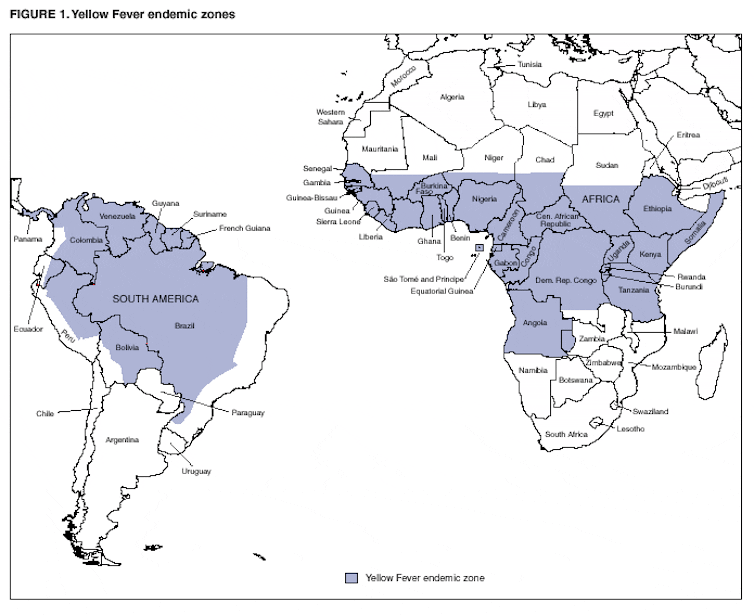Of the dangers facing travellers to Brazil for the World Cup, yellow fever is one of the least likely to pose a real threat. But there are two important things to know about the illness.
First, it’s a deadly disease (of the nine cases reported in unvaccinated travellers in Europe and North America between 1970 and 2002, eight people died).
Second, an effective vaccine exists and unlike other travel-related vaccines, it may be a legal requirement for travellers to endemic areas to have a vaccination certificate.
What is yellow fever?
Yellow fever is a viral haemorrhagic fever; its name comes from jaundice, which is caused by the yellowish pigment called bilirubin that accumulates in the body after liver failure.
Like some of the other haemorrhagic fevers, the initial symptoms are non-specific – fever, muscle aches, dizziness and vomiting. After a few days, the disease can take one of two courses – either patients recover, or after a few days of apparent improvement, they rapidly deteriorate and their internal organs fail.
In people who reach this third phase, about 20% will die of the disease, which tends to affect the old and the very young.
Studies in the 1990s estimated that there were around 200,000 cases of yellow fever each year, including around 30,000 deaths. But the vast majority were residents of endemic areas rather than travellers.

Currently, most cases are found in a broad swathe of countries including in Central and West Africa. But many parts of South America have reported outbreaks including central and southeastern Brazil, northeastern Argentina and Paraguay.
In Brazil, the risky regions include some popular tourist areas such as Iguazu Falls, Brasilia and other places within the Amazon Basin, where sylvatic (jungle-associated) transmission still occurs.
The urban areas of Fortaleza, Recife, Rio de Janeiro, Salvador, and São Paulo pose little risk for yellow fever.
A curious history
The discovery of how yellow fever is transmitted was a curious one.
Yellow fever was a particular problem for American troops occupying Cuba after the 1900 Spanish-American War. Walter Reed, after whom the famous American military hospital and research institute were later named, supervised experiments involving bites from infected mosquitoes to ascertain if they were indeed the spreaders of the disease.
The experiments resulted in 29 cases and five deaths, which included one of the physicians. Since then, the volunteers have been variously portrayed as selfless and willing to risk their lives to contribute to knowledge about prevention of an important, deadly disease.
But others have questioned the ethics of Reed. The three physicians had agreed to first perform the experiment on themselves, but Reed was apparently summoned to Washington abruptly and later conducted the experiments on volunteers rather than himself.
The truth is probably more complex and will now not be known as participants had a number of different motivations for joining in, including monetary inducements and the promise of medical care (and future immunity from disease for survivors).

But it was certainly appreciated at that time that the volunteers were taking significant risks, and the experiments probably wouldn’t be permitted by modern ethics committees.
Preventing yellow fever
The good news is that yellow fever is one of the only viral haemorrhagic fevers that’s preventable. A vaccine has been available since the 1930s, made from a weakened strain of the virus.
In Australia, only one vaccine brand (Stamaril) is currently available, and it must be obtained from registered vaccinators.
Serious reactions to the vaccine are rare (in the order of a few cases per million vaccinations) but may occur in people with weakened immune systems (such as those with HIV/AIDS). Special precautions may also be necessary in people with egg or other allergies, in infants and in older people – see your doctor for specific advice.
Even of you get the vaccine, avoiding mosquitoes is recommended by covering up exposed areas of the body and using DEET-containing repellents - not only to prevent yellow fever, but other mosquito-borne diseases, such as dengue and malaria.
Because of its high fatality rate and the widespread presence of the transmitting mosquito in some regions (including in northern Australia), International Health Regulations require travellers to endemic countries to produce a vaccination certificate.
If you don’t have a certificate on return to Australia, you’ll still be allowed in (but may be delayed at the airport to be given advice).
But in some countries, failure to produce a vaccination certificate after being in an endemic country may lead to quarantine or refusal of entry.

